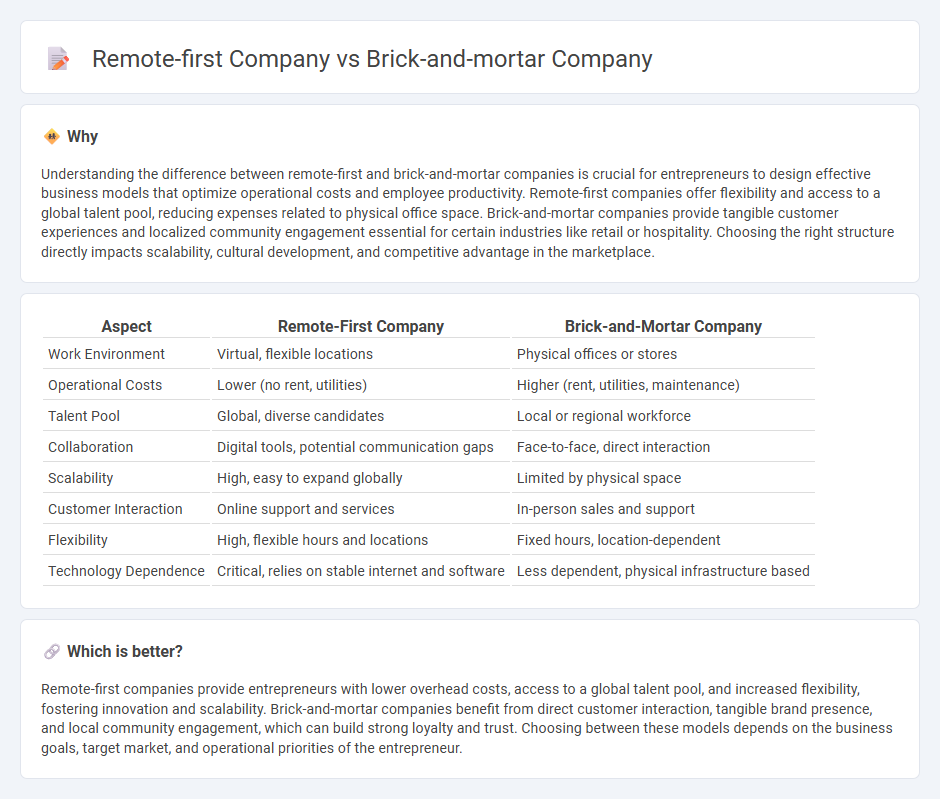
Remote-first companies leverage digital tools and flexible work arrangements to reduce overhead costs, expand talent pools globally, and enhance employee work-life balance, contrasting with brick-and-mortar companies that prioritize physical office spaces for direct collaboration and local market presence. Brick-and-mortar businesses often face higher fixed costs, such as rent and utilities, but benefit from in-person customer interactions and community engagement. Explore the advantages and challenges of both models to determine which entrepreneurial approach aligns best with your business goals.
Why it is important
Understanding the difference between remote-first and brick-and-mortar companies is crucial for entrepreneurs to design effective business models that optimize operational costs and employee productivity. Remote-first companies offer flexibility and access to a global talent pool, reducing expenses related to physical office space. Brick-and-mortar companies provide tangible customer experiences and localized community engagement essential for certain industries like retail or hospitality. Choosing the right structure directly impacts scalability, cultural development, and competitive advantage in the marketplace.
Comparison Table
| Aspect | Remote-First Company | Brick-and-Mortar Company |
|---|---|---|
| Work Environment | Virtual, flexible locations | Physical offices or stores |
| Operational Costs | Lower (no rent, utilities) | Higher (rent, utilities, maintenance) |
| Talent Pool | Global, diverse candidates | Local or regional workforce |
| Collaboration | Digital tools, potential communication gaps | Face-to-face, direct interaction |
| Scalability | High, easy to expand globally | Limited by physical space |
| Customer Interaction | Online support and services | In-person sales and support |
| Flexibility | High, flexible hours and locations | Fixed hours, location-dependent |
| Technology Dependence | Critical, relies on stable internet and software | Less dependent, physical infrastructure based |
Which is better?
Remote-first companies provide entrepreneurs with lower overhead costs, access to a global talent pool, and increased flexibility, fostering innovation and scalability. Brick-and-mortar companies benefit from direct customer interaction, tangible brand presence, and local community engagement, which can build strong loyalty and trust. Choosing between these models depends on the business goals, target market, and operational priorities of the entrepreneur.
Connection
Remote-first companies and brick-and-mortar companies are connected through their shared goal of driving entrepreneurship and business growth. Both models leverage distinct operational strategies to optimize productivity, with remote-first companies utilizing digital tools and flexible workflows, while brick-and-mortar businesses focus on physical customer experiences and local market engagement. Hybrid entrepreneurial ventures increasingly blend these approaches to maximize reach, operational efficiency, and market adaptability.
Key Terms
Physical Infrastructure
Brick-and-mortar companies invest heavily in physical infrastructure such as offices, retail stores, and warehouses to support their operations and customer interactions. Remote-first companies prioritize digital tools and cloud-based platforms, minimizing physical assets and enabling distributed workforces worldwide. Explore the advantages and challenges of each model to determine which best suits your business strategy.
Distributed Workforce
Brick-and-mortar companies typically operate from physical offices, centralizing their workforce and fostering in-person collaboration, which can limit geographic diversity and flexibility. Remote-first companies prioritize distributed workforces, enabling talent acquisition from various locations, reducing overhead costs, and enhancing employee work-life balance. Explore how adopting a distributed workforce model can transform business operations and employee engagement.
Operational Overhead
Brick-and-mortar companies incur substantial operational overhead through expenses like physical office rent, utilities, maintenance, and on-site staff management. Remote-first companies reduce these costs by leveraging digital communication tools and cloud-based infrastructure, enabling flexible work environments with lower fixed expenses. Explore how operational overhead differences impact overall business efficiency and scalability.
Source and External Links
Brick and mortar - Wikipedia - A brick-and-mortar company is a business with a physical presence in a building or structure, such as retail shops or warehouses, which contrasts with online-only businesses that lack physical storefronts for customer interaction.
Brick and Mortar Stores: Types, Benefits, Examples (2024) - Shopify - Brick-and-mortar stores are traditional retail locations where customers can physically browse, try, and purchase products with in-person assistance, often serving as hubs for omnichannel shopping experiences like buy online, pick up in-store.
Brick and Mortar: Everything There Is To Know - BlueCart - Brick-and-mortar businesses operate primarily through face-to-face sales in physical locations, including examples like Walmart, Target, and McDonald's, and can range from local stores to large multi-category retailers.
 dowidth.com
dowidth.com